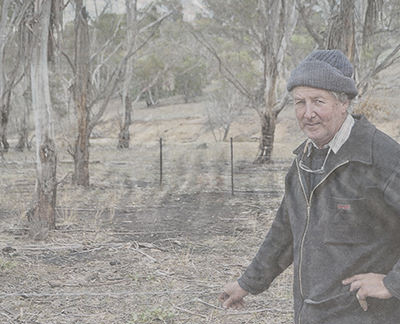
Massy trials fire stick methods in Monaro
By Stephen Burns – Thursday, July 07, 2016

Transferring from the conventional direction of his family’s property to regenerative methods of land management is the aim of Monaro grazier, Charlie Massy.
The author of Australian Merino and Breaking the Sheep’s Back runs a Merino operation on “Severn Park” Bobundra via Cooma. His latest foray into the spotlight has been for a ‘new’ approach of land management. He held a field day to demonstrate the time-honoured indigenous practice of fire-stick farming after having questioned the accepted systems on the Monaro since he took part in a Resource Consulting Services (RCS) Grazing for Profit school during the early 1990s.
“The concepts made a lot of sense and I incorporated ideas such as holistic grazing and regenerative agriculture on our property to ensure continuity for future generations” Mr Massy said. Mr Massy has recently completed his PhD focusing on regenerative agriculture in the Australian context, which he said exposed him to indigenous practices.
He is working closely with Monaro region Ngarigo aboriginal elder Rod Mason, who spent his youth in the central deserts where he learnt to burn in spinifex country. “Rod Mason is highly skilled with the practice of burning for the past 50 years and he is passing on his knowledge” Mr Massy said.
During the field day, Mr Massy burnt two half-hectare plots which were also fenced. The aim was to demonstrate the restoration of native shrub, flower and tree populations before they were lost. “I firmly believe we continue to trash our landscape because, as Europeans we have never really learnt to read the land in the same manner as the indigenous people did for 40,000 years. We don’t understand the key landscape functions and what we are trying to do here is get them fully working again” he said. “We followed the aboriginal approach by having a slow, cool burn during late autumn, early winter, which, as trials have shown along with indigenous knowledge, should give us four times the recruitment of native species than if it was subjected to a hot summer burn.”
Mr Massy emphasised the practice was not new, with indigenous burning utilising the plant’s adaptations to fire throughout millions of years. “Some Indigenous people believe the die-back of certain populations of eucalypts on the Monaro and other regions has occurred because of the lack of burning” he said. “Burning gets the ecology going… it kills pests which threaten plants, kills exotic seed loads, puts charcoal back into the soil and it generates the germination of native plant seed and tubers.”
